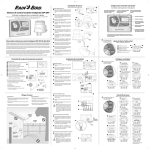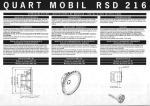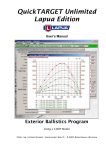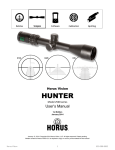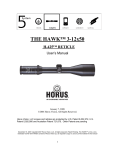Download model internals [how it works]
Transcript
Revised August 2014 PRACTICE SAFE FIREARMS HANDLING AND FOLLOW ALL SAFETY RULES! index TOPIC SUMMARY Introduction Summary of Shooter’s Reference V3 and what’s new Cartridge Database How to use the cartridge database ● search Look up a cartridge by firearm type, caliber, use, manufacturer 4 ● specs View the specs of a selected cartridge 5 Ballistics Model How to use the ballistics calculator ● setup Set up cartridge, ambient, range and firearm parameters 6 ● solve Calculate solution at distance, bearing and inclination 11 ● hold View mil scope display hold for calculated solution 16 ● table View range table with drop and drift corrections 17 Other Tools A collection of other handy tools and calculators ● sight-in Dial in your scope on the range 18 ● range Determine the range of an object of known size 19 ● convert MOA / Mils converter 20 ● safety rules Col. Jeff Cooper’s rules four rules 21 Appendix Other stuff you might want to know ● model internals How the ballistics model works 23 ● model performance Comparison of model vs manufacturers published ballistics 33 SHOOTER’S REFERENCE V3 COPYRIGHT © 2014 THIS TIME FOR SURE APPS LLC PAGE 3 introduction [getting started] Shooter’s Reference V3 is a ballistics calculator for sports shooting enthusiasts that features a classical physics-based projectile motion model, cartridge database, and several other useful tools. The V3 ballistics model supports G1 and G7 drag models (as well as many others), BC (ballistic coefficient) and ambient weather conditions compensation yielding accurate bullet drop and wind drift solutions. For ease of use, Shooter’s Reference has a built-in database of over 2,000 cartridges from Barnes®, Buffalo Bore®, CCI®, Eley®, Federal Premium®, Fiocchi®, Hornady®, Norma-USA®, Nosler®, PMC®, Remington®, Weatherby®, and Winchester®. In addition, the user can manually enter the required input parameters such as muzzle velocity and bullet weight. Additional tools are included that aid sight-in calculations at the range, estimating the distance to a target, and performing mils and moa calculations. Both imperial and metric units are supported. Contact Us [email protected] WARNING! PRACTICE SAFE FIREARMS HANDLING AND FOLLOW ALL SAFETY RULES! ALWAYS!!! Comments, complaints, suggestions, and questions are appreciated. SHOOTER’S REFERENCE V3 COPYRIGHT © 2014 THIS TIME FOR SURE APPS LLC 3 search [find your cartridge’s specs in the built-in database] Cartridge Database In order to set up the ballistics calculator, there are a few parameters you need to know about your cartridge. We have included a database of over 2,600 popular rifle and handgun cartridges that can be searched simply by tapping the search boxes on the search page. Tap the products box to see the list of cartridges that match your criteria and to choose one. Note that a maximum of 100 products can be displayed. The best way to avoid that limit is to choose a cartridge. The parameters required by the ballistics calculator are automatically loaded into the setup page when a product is selected. The following parameters are extracted: Bullet diameter Bullet weight Ballistic coefficient (optional, not required) Muzzle velocity Muzzle energy (not used, but displayed) SHOOTER’S REFERENCE V3 COPYRIGHT © 2014 THIS TIME FOR SURE APPS LLC 4 specs [view manufacture’s data and description] Cartridge Specs When a cartridge is selected from the database, a summary of the its specifications is displayed on the specs page. The specs are from the manufacturer and are subject to change. Typically, the following specifications are available: Manufacturer, product line, and part number Cartridge and bullet description Typical application Bullet weight and ballistic coefficient Muzzle velocity Muzzle energy SHOOTER’S REFERENCE V3 COPYRIGHT © 2014 THIS TIME FOR SURE APPS LLC 5 setup [setup model parameters] Model Setup Cartridge and Bullet Parameters These parameters describe the cartridge and bullet. bullet caliber ► Required, inches or mm, depending common usage bullet weight ► Required, always in grains ballistic coefficient ► Only required if use bc box is checked ► Default is to not use BC in ballistics model (yields best results) ► Can be applied to any of the bullet models but most manufacturers only specify a G1 BC bullet model ► Required, G7 default ► G7 works best for low drag bullets ► See page 30, Standard Bullet Models for more information SHOOTER’S REFERENCE V3 COPYRIGHT © 2014 THIS TIME FOR SURE APPS LLC 6 setup [setup model parameters] Model Setup (continued) Cartridge and Bullet Parameters (continued) use bc ► Not required or recommended ► If checked, ballistics model applies BC to selected bullet model’s drag coefficient muzzle velocity ► Required, in fps or mps muzzle energy ► Displayed for information only, in ft-lbs or Joules SHOOTER’S REFERENCE V3 COPYRIGHT © 2014 THIS TIME FOR SURE APPS LLC 7 setup [setup model parameters] Model Setup (continued) Ambient Conditions Entering ambient conditions allow Shooter’s Reference to calculate wind drift corrections as well as air density compensation. U.S. Army Standard Metro conditions are the default. wind speed ► Optional, in mph or kph wind direction ► Optional, in degrees, using meteorological convention (see illustration on page 13) elevation ► Optional, in feet or meters above sea level) ► If zero, temperature, humidity and pressure are used to calculate air density (most accurate method) ► If non-zero, then altitude is used to calculate air density (better than no air density correction) SHOOTER’S REFERENCE V3 COPYRIGHT © 2014 THIS TIME FOR SURE APPS LLC 8 setup [setup model parameters] Model Setup (continued) Ambient Conditions (continued) temperature ► Optional, in degrees Fahrenheit or Celsius humidity ► Optional, in RH percent pressure ► Optional, in inches of Mercury or hectoPascals Tip: If exact ambient conditions are not available, a good guess at temperature and humidity while leaving the pressure at the default value will improve the ballistic model’s results. SHOOTER’S REFERENCE V3 COPYRIGHT © 2014 THIS TIME FOR SURE APPS LLC 9 setup [setup model parameters] Model Setup (continued) Firearm Setup The model uses the scope mounting height and the zero distance to calculate the bore angle of the firearm relative to the line of sight. The centerline to centerline height of the scope relative to the barrel is critical to the accuracy of the model. scope height ► The centerline to centerline height of the scope or sights to the barrel ► Required, in inches or millimeters zero distance ► Required, in yards or meters Measurement Units Metric units are used internally. Input and display units can be toggled at any time by checking/unchecking this box. input units ► Required, in yards or meters SHOOTER’S REFERENCE V3 COPYRIGHT © 2014 THIS TIME FOR SURE APPS LLC 10 solve [enter target data and solve model] Find a Solution The target distance, bearing, and inclination angle are entered on the solve page. Press the solve button to calculate the solution. distance ► The line of sight distance to the target ► Required, in yards or meters bearing ► The target bearing ► Required, in degrees inclination angle ► The target inclination angle (see illustration on page 13) ► Required, in degrees The line of sight distance (also referred to as the slant range) is the straight line distance as measured to the target. The ballistics model uses the Rifleman’s Rule to calculate the horizontal distance to the target. This compensates for uphill or downhill shooting situations. SHOOTER’S REFERENCE V3 COPYRIGHT © 2014 THIS TIME FOR SURE APPS LLC 11 solve [enter target data and solve model] The inclination angle is the angle of the target relative to the shooter. A 0° inclination is horizontal, flat ground. Positive inclination angles indicate an uphill shot while negative inclination angles indicate a downhill shot. Please refer to Wikipedia for an explanation of the Rifleman’s Rule. Source: http://en.wikipedia.org/wiki/Rifleman's_rule SHOOTER’S REFERENCE V3 COPYRIGHT © 2014 THIS TIME FOR SURE APPS LLC 12 solve [enter target data and solve model] The bearing is the compass bearing of the target. Wind Direction 315° N 0° Target Bearing 45° W 270° E 90° Target Bearing 225° S 180° Tip: Target bearing is the direction in which the firearm is pointing. Wind direction is where the wind is blowing from (meteorological convention). SHOOTER’S REFERENCE V3 COPYRIGHT © 2014 THIS TIME FOR SURE APPS LLC 13 solve [enter target data and solve model] Click the solve button to calculate the solution. Drop and drift are displayed in length units as well as mils and MOA’s. “U” and “D” preceding a number refer to up and down while “L” and “R” preceding a number refer to left and right sight adjustments. For example, in the screenshot to the right, the sights should be adjusted up 2.7 MOA or 0.8 mils to account for bullet drop. 2.6 MOA or 0.4 mils left must be dialed-in to account for wind drift. The kinetic energy and bullet velocity at the target distance are also displayed. Kinetic energy is displayed in either ft-lb or Joules. Velocity is displayed in feet per second (fps) or meters per second (mps). Bore Laser Sight The laser bore sight solution displays the two key numbers required to sight-in a firearm at a desired zero distance when using a bore laser light such as the SITELITE® Mag Laser Boresighters ®. The laser / LOS intercept is the distance at which the bore laser line and the line of sight cross. It is displayed in yards or meters. If you place a target at this distance, the laser dot on the target should be right in the center of the scope or on the front sight. SHOOTER’S REFERENCE V3 COPYRIGHT © 2014 THIS TIME FOR SURE APPS LLC 14 solve [enter target data and solve model] The laser position on target is the distance from the sight position to the laser dot on the target required to achieve the desired zero distance. The target distance is the value entered for distance under target parameters. Tip: In addition to the target distance, the bore sight calculator requires the ballistics of the cartridge in use and the mounting height of the scope or sights. The cartridge ballistic specs can be manually entered in the setup page or by selecting a cartridge in the search page. Consult your laser bore sight manufacturer’s user’s manual for instructions specific to your model. SHOOTER’S REFERENCE V3 COPYRIGHT © 2014 THIS TIME FOR SURE APPS LLC 15 hold [sight picture] Mil-Dot Sight Picture Once a solution is found, the hold page displays the “hold” position required to be on target at the distance, bearing, and inclination angle entered on the solve page. Holding the firearm such that the target is in the position indicated by the green dot, will place the shot on the target. The vertical axis is labeled in half mil-dot increments with the ontarget distances corresponding to that vertical hold. The horizontal axis is also labeled in half mil-dot increments with the distances corresponding to wind drift. For example, a 350 yard shot would require a vertical hold of just under 1 mil (352 yards) for drop and about 0.7 mils (0.7 x 500 yards) for wind drift. When metric units are selected, sight picture values are displayed in meters. SHOOTER’S REFERENCE V3 COPYRIGHT © 2014 THIS TIME FOR SURE APPS LLC 16 table [view drop and drift correction table] Drop and Drift Table Once a solution is found, the table page displays the drop and drift solution from 50 to 500 yards or meters at 5 yard or meter increments at a zero degree inclination angle. “U” and “D” preceding a number refer to up and down while “L” and “R” preceding a number refer to left and right sight adjustments. SHOOTER’S REFERENCE V3 COPYRIGHT © 2014 THIS TIME FOR SURE APPS LLC 17 sight-in [sight-in your rifle at the range] Sighting-in on the Range The sight-in page provides a simple, non-model method of zeroing a firearm on the range. target distance ► Required, in yards or meters vertical adjustment ► Required, in inches or centimeters ► The vertical distance to move the impact point. Enter a positive value to move the impact point up, a negative value to move the impact point down. horizontal adjustment ► Required, in inches or centimeters ► The horizontal distance to move the impact point. Enter a positive value to move the impact point right, a negative value to move the impact point left. Tip: Use 3-5 rounds and average the distance from the target center for best results. SHOOTER’S REFERENCE V3 COPYRIGHT © 2014 THIS TIME FOR SURE APPS LLC 18 range [estimate target range using mil scope] Estimating Range Using a Mil/MOA Scope The range page provides a simple method of estimating the range of a target given its actual size and apparent size in mils or MOA. actual size ► Required, in inches or centimeters ► The actual height of the target area being measured scope size ► Required, in mils or MOA ► The apparent height of the target area being measured scope units ► Required, choose mils or MOA ► Determines table increment display table increment ► Required, choose 1/8th or 1/10th increments ► Determines range table increment display SHOOTER’S REFERENCE V3 COPYRIGHT © 2014 THIS TIME FOR SURE APPS LLC 19 convert [convert distances to mils and moa] Converting Mils or MOA The convert page provides a simple calculator to determine the value of Mils or MOA’s at a given distance. distance ► Required, in yards or meters ► The target distance The value of both a Mil and MOA (or quarter fractions) is displayed in inches or centimeters. SHOOTER’S REFERENCE V3 COPYRIGHT © 2014 THIS TIME FOR SURE APPS LLC 20 safety rules [read them. learn them. live them.] Lt. Col. Jeff Cooper (USMC), founder of Gunsite Academy, author, columnist, professor, WW II and Korean War combat veteran, and innovator of the Modern Technique of the Pistol had four simple safety rules: ALL FIREARMS ARE ALWAYS LOADED NEVER LET THE MUZZLE OF A FIREARM POINT ANYTHING YOU ARE NOT WILLING TO DESTROY KEEP YOUR FINGER OFF THE TRIGGER UNTIL YOUR SIGHTS ARE ON THE TARGET BE SURE OF YOUR TARGET THE IMPORTANCE OF THESE RULES CAN NOT BE STRESSED ENOUGH. THE MOST IMPORTANT SAFETY FEATURE WHEN HANDLING A FIREARM IS THE ONE BETWEEN YOUR EARS, NOT THE ONES ON THE FIREARM. SHOOTER’S REFERENCE V3 COPYRIGHT © 2014 THIS TIME FOR SURE APPS LLC 21 APPENDIX Model internals Model performance model internals [how it works] Shooter’s Reference’s ballistics model is based on Newtonian physics. This section describes the inner workings of the model in mathematical terms. Basic knowledge of physics and calculus is required to understand the model but is not a prerequisite for using the application. Several good books available as well as Wikipedia’s articles on external ballistics and related topics as well as many other Internet sources. Our preferred source is Bryan Litz’s excellent book. Litz, Bryan (2011), Applied Ballistics for Long Range Shooting (2nd edition), Cedar Springs, MI, Applied Ballistics LLC. The ballistics model can be divided into three functional blocks. Ambient Conditions Firearm Setup Projectile Motion Simulation SHOOTER’S REFERENCE V3 Ambient Conditions There are three factors that are important to calculating an accurate trajectory: air density, the speed of sound, and crosswind speed. Air density can be calculated one of two ways by the model. The preferred method is to use temperature, pressure and humidity at the shooter’s location. Alternatively, the model can use elevation and sea level temperature, pressure and humidity or their approximation. In reality, for hunting distances out to 500 yards, air density is a very small factor in bullet drop or drift, typically on the order of tenths of an inch. By comparison, we see several inches of variation when comparing trajectories generated by utilizing the G7 model instead of the G1+BC model (see comparisons in Appendix). COPYRIGHT © 2014 THIS TIME FOR SURE APPS LLC 23 model internals [how it works] To determine air density from temperature, pressure and humidity we employ the following equations: First, we calculate the saturation pressure for water vapor from a rather complicated magical formula that uses temperature only. . = = − Next, we calculate the partial pressure of the water vapor from the relative humidity and the saturation pressure. This is a very small number, on the order of 1-2% of the total atmospheric pressure. = 100 × The density of a mixture of dry air and water follows: !"# = ×$ + ×& ×$ The speed of sound varies with air density and is given by: Before we calculate the partial pressure of dry air, we need to know the local atmospheric pressure. This can be measured directly or obtained from your favorite weather website. SHOOTER’S REFERENCE V3 ' The partial pressure of dry air can be determined by simple subtraction: . . = If the local atmospheric pressure can not be determined, an approximation can be made based on altitude and either actual nearby or standard sea level pressure. ( = ) × COPYRIGHT © 2014 THIS TIME FOR SURE APPS LLC !"# 24 model internals [how it works] Firearm Setup Bore angle is the barrel cant that results from the difference between the line of sight to the target (what you see through the scope or sights) and the launch angle required to be on target at the zero distance on flat ground. Shooter’s Reference allows the user to choose an arbitrary zero distance. A zero distance that is close to the target range is recommended. For example, when targets are likely to be around 75 yards away, set the zero distance to 75 yards. Bore angles are typically very small, around 0.05 to 0.10 degrees. However, a small variation can result in several inches of error at 500 yards. Shooter’s Reference calculated zero at the actual zero distance is ±0.05 inches (±1.27mm). Source: http://en.wikipedia.org/wiki/Rifleman's_rule Most manufacturers’ ballistics tables assume a height of 1.5 inches but chances are that your sights or scope are not mounted at that height. This is a significant source of error. The centerline to centerline height of the sights or scope above the barrel is required to calculate the bore angle. This measurement is critical and should be taken with care. SHOOTER’S REFERENCE V3 Source: http://en.wikipedia.org/wiki/Rifleman's_rule The zero distance and scope height entered on the setup page is used to generate a custom drop table for your cartridge and firearm. The ballistics model uses an iterative process that takes into account the cartridge, bullet and ambient conditions to determine the bore angle. COPYRIGHT © 2014 THIS TIME FOR SURE APPS LLC 25 model internals [how it works] The zero correction in mils and moa is displayed on the solve page and the bore angle is used by the ballistics model along with the inclination angle to generate the solution at the target distance as well as the custom drop table. Projectile Motion Simulation Once the ambient conditions, firearm, and cartridge/bullet parameters are set, the ballistics model generates a solution at the user specified distance on the solve page and for each distance point in the accompanying drop/drift table page. Bullet drag is calculated using one of two formulas depending on whether the user has selected the “use BC” option on the setup page. It is recommended that the “use BC” option is not used and that instead a bullet model that most closely matches the bullet in use be chosen. BC’s are not constant with speed although manufacturers quote a single BC, typically based on the G1 model in their cartridge specifications. SHOOTER’S REFERENCE V3 Using the manufacturer’s BC introduces a systemic error and results in larger errors. The Appendix shows model results for three common cartridges with and without BC compensation. For modern low drag bullets, the G7 model without BC compensation provides the best results. The ballistics model implements a table of drag coefficients for each of the supported bullet models developed by the Army Ballistics Research Lab. These are discussed in the bullet models section. A new drag is calculated for each trajectory point based on the bullet’s velocity at that point. The two equations for calculating drag are: * - + ×, ×= 2 + -0123 × 4 = 5- × 6 COPYRIGHT © 2014 THIS TIME FOR SURE APPS LLC + ×. [IfBCisused] 26 model internals [how it works] The ballistics model simulates the path of the projectile, or bullet, by repeatedly calculating its drag, velocity, acceleration, and position at intervals of either 0.5 yards or meters depending on whether Imperial or metric units are selected. Since the projectile is launched at an angle (at a minimum the bore angle on flat ground), it is necessary to determine its velocity in both the x and y axes. In addition, the forces of gravity and drag act differently in both axes so those must also be treated separately. The initial conditions are determined by the muzzle velocity and the launch angle. The launch angle is determined by the inclination angle to the target and the bore angle of the “zeroed” firearm. The initial velocities in the x and y axes are given by: The model performs calculations based on units of time, t, required to travel the model distance interval. QR = QS ,H( ) ) = ,"!EEFG , = ,( ) × cos(K + L) ( ) = ,( ) × sin(K + L) Acceleration is given by the general vector formula: Acceleration (deceleration in this case) can be approximated as follows for each axis: NH = − SHOOTER’S REFERENCE V3 ) *O NO = 4 The initial velocity is the muzzle velocity. ,( ,H( * + 4 COPYRIGHT © 2014 THIS TIME FOR SURE APPS LLC and N = −P + * + 4 27 model internals [how it works] Given velocity, acceleration and time, a new position can be calculated. NH × QR 2 N × QR + × QR ) 2 S( 1) = S( ) + ,H( ) × QR + T( 1) = T( ) + , ( New velocities are similarly updated. ,( ,H 1 = ,H + NH × QR , 1 =, + N × QR = ,H( 1) 1) +, ( 1) Since the projectile is now moving more slowly, the time to travel to the next computation point also needs to be recalculated.. QR = Wind Drift Wind drift is calculate using the Army Ballistics Lab method described in: Leupold, Herbert A. (October 1996), Wind Drift of Projectiles: A Ballistics Tutorial, ARL-TR-1124. The full text may be downloaded from: http://www.dtic.mil/dtic/tr/fulltext/u2/a317305.pdf The amount of drift requires the calculation of the perpendicular wind speed, the actual time of flight, and the time of flight in a vacuum. The time of flight in a vacuum is simply the time to travel the horizontal distance at the muzzle velocity since there is no drag to slow the projectile’s velocity while in flight. S R = , QS ,H( 1) The process repeats until the drop and drift table is completed and the target distance reached. SHOOTER’S REFERENCE V3 The wind drift is calculated with the following equation: S =, × R − R COPYRIGHT © 2014 THIS TIME FOR SURE APPS LLC 28 model internals [how it works] Kinetic Energy Kinetic energy is calculated at the target range. While kinetic energy is a good indicator of a bullet’s ability to stop and/or kill game, it is not the only factor. The user of this program should consult the manufacturer’s recommendations for specific game. A small bullet with high kinetic energy does not perform the same as a large bullet with the same kinetic energy. Kinetic energy is calculated as follows: UV = 4 × , 2 SHOOTER’S REFERENCE V3 COPYRIGHT © 2014 THIS TIME FOR SURE APPS LLC 29 model internals [how it works] VARIABLE T DESCRIPTION VARIABLE DESCRIPTION temperature QS calculation interval distance relative humidity QR calculation interval time p barometric pressure *O force vector p0 sea level barometric pressure 4 mass psat vapor saturation pressure NO acceleration vector pwv partial pressure of water vapor 6 diameter of bullet pdry partial pressure of dry air * + drag force density of humid air - + drag coefficient , perpendicular (cross) wind speed -0123 drag coefficient of G1 std. model ℎ elevation NH , N acceleration at time t in x or y ℎ height of the atmosphere ( speed of sound R universal gas constant RH ρhumid ,( velocity at time t ) ,H( ) , , S( ) , T( ( ) velocity at time t in x or y ) position at time t $ molar mass of water vapor S horizontal distance $ molar mass of dry air R time of flight in a vacuum adiabatic index R actual time of flight ) SHOOTER’S REFERENCE V3 COPYRIGHT © 2014 THIS TIME FOR SURE APPS LLC 30 model internals [how it works] MODEL Standard Bullet Models Shooter’s Reference allows the user to select various standard models that are used to calculate bullet drag. By choosing the model that best fits your bullet, you can improved the accuracy of the results. Shooter’s Reference continuously adjusts drag based on the instantaneous velocity of the bullet based on the selected bullet shape model. The descriptions of the bullet models in the table to the right refer to the terms “blunt ogive” “secant ogive” with and “tangent ogive.” These describe the shape of the bullet’s nose and date back to nose cone designs for rockets. More information on nose cone designs is available on Wikipedia: http://en.wikipedia.org/wiki/Nose_cone_design SHOOTER’S REFERENCE V3 DESCRIPTION G1 Ingalls. Flatbase. 2 caliber blunt ogive nose. Generally used by manufactures to express BC. G2 Aberdeen J projectile. G5 Short 7.5° boat-tail. 6.19 caliber tangent ogive nose. G6 Flatbase. 6 caliber secant ogive nose. G7 Default Model Long 7.5° boat-tail. 10 caliber tangent ogive nose. Best model for low drag bullets. Some manufacturers provide G7 BC’s in addition to G1 BC’s. G8 Flatbase. 10 caliber secant ogive nose. GL Blunt lead nose. Source: http://en.wikipedia.org/wiki/External_ballistics COPYRIGHT © 2014 THIS TIME FOR SURE APPS LLC 31 model internals [how it works] Manufacturers typically provide a BC (ballistics coefficient) that is based on the G1 model. Some have also started providing G7 based BC’s. However, best results are achieved without using BC compensation because BC’s vary with velocity. The G1 and GL models will yield very similar results, typically within 0.5 inches (1.3 cm) of drop at 500 yards (457m). The G2, G5, G6, G7, and G8 models also yield similar results. Since most long range shooters are using very low drag boat-tails for best performance, the G7 model yields the best results. Results of comparisons of manufacturer’s data compared with the model solutions, with and without BC compensation are provided for the Winchester 308, Winchester 338 Lapua Magnum and the Winchester 300 Magnum. G1 G7 G1 GL G7 G7 Bullet Shape and Recommended Model Cd vs. Velocity (mach) 0.7 0.6 0.5 0.4 0.3 0.2 0.1 G1 G7 0.0 0.0 SHOOTER’S REFERENCE V3 0.5 1.0 COPYRIGHT © 2014 THIS TIME FOR SURE APPS LLC G2 G8 1.5 2.0 G5 GL 2.5 G6 3.0 3.5 4.0 User’s Guide ---- Page 32 model performance data [300 winchester magnum] 300 Win Mag (Winchester GM300WM) -Manufacturer's Data vs. Shooter's Ref Model Distance (yds) 0 100 200 300 400 500 Δ @ 500 V (fps) Manufacturer 2900 2726 2558 2396 2240 2090 SR Model G7 2900 2730 2566 2406 2249 2093 3 SR Model G1 + BC 2900 2710 2526 2348 2178 2018 -72 E (ft-lbs) Manufacturer 3548 3134 2760 2422 2117 1843 SR Model G7 3548 3145 2777 2441 2133 1847 4 SR Model G1 + BC 3548 3097 2691 2325 2001 1718 -125 D (in) Manufacturer -1.5 1.6 0.0 -6.9 -19.9 -39.8 SR Model G7 -1.5 1.6 0.0 -7.1 -20.8 -42.7 -2.9 SR Model G1 + BC -1.5 1.6 0.0 -7.3 -21.8 -44.9 -5.1 W (in) Manufacturer 0.0 0.6 2.4 5.5 10.1 16.4 SR Model G7 0.0 0.7 2.4 5.4 9.9 16.0 -0.4 SR Model G1 + BC 0.0 0.7 2.7 6.2 11.3 18.2 1.8 20 20 300 Win Mag Drop (inches) 0 0 -20 -20 -40 -40 G7 Model Manufacturer's Data -60 0 100 SHOOTER’S REFERENCE V3 200 300 300 Win Mag Drop (inches) G1 Model with BC Correction Manufacturer's Data -60 400 500 0 100 COPYRIGHT © 2014 THIS TIME FOR SURE APPS LLC 200 300 400 500 33 model performance data [338 winchester lapua magnum] 338 Lapua Mag (Winchester GM338LM) - Manufacturer's Data vs. Shooter's Ref Model Distance (yds) 0 100 200 300 400 500 Δ @ 500 V (fps) Manufacturer 2950 2789 2634 2484 2339 2199 SR Model G7 2950 2785 2625 2469 2316 2166 -33 SR Model G1 + BC 2950 2775 2606 2441 2282 2130 -69 E (ft-lbs) Manufacturer 4830 4318 3851 3426 3037 2685 SR Model G7 4830 4305 3824 3382 2977 2603 -82 SR Model G1 + BC 4830 4275 3768 3307 2890 2519 -166 D (in) Manufacturer -1.5 1.5 0.0 -6.5 -18.5 -37.1 SR Model G7 -1.5 1.5 0.0 -6.7 -19.8 -40.4 -3.3 SR Model G1 + BC -1.5 1.5 0.0 -6.8 -20.2 -41.4 -4.3 W (in) Manufacturer 0.0 0.5 2.1 4.9 8.8 14.3 SR Model G7 0.0 0.6 2.2 5.1 9.2 14.9 0.6 SR Model G1 + BC 0.0 0.6 2.4 5.4 9.9 15.9 1.6 20 20 338 Lapua Mag Drop (inches) 0 0 -20 -20 -40 -40 G7 Model Manufacturer's Data -60 0 100 SHOOTER’S REFERENCE V3 200 338 Lapua Mag Drop (inches) G1 Model with BC Correction Manufacturer's Data -60 300 400 500 0 100 COPYRIGHT © 2014 THIS TIME FOR SURE APPS LLC 200 300 400 500 34 model performance data [308 winchester] 308 Win (Winchester AE308D) - Manufacturer's Data vs. Shooter's Ref Model Distance (yds) 0 100 200 300 400 500 Δ @ 500 V (fps) Manufacturer 2820 2597 2385 2183 1990 1808 SR Model G7 2820 2598 2384 2175 1967 1767 -41 SR Model G1 + BC 2820 2575 2342 2122 1921 1749 -59 E (ft-lbs) Manufacturer 2648 2246 1894 1586 1319 1089 SR Model G7 2648 2248 1892 1576 1289 1040 -49 SR Model G1 + BC 2648 2209 1826 1499 1229 1018 -71 D (in) Manufacturer -1.5 1.8 0.0 -8.0 -23.3 -47.2 SR Model G7 -1.5 1.8 0.0 -8.3 -25.2 -53.3 -6.1 SR Model G1 + BC -1.5 1.8 0.0 -8.7 -26.4 -55.8 -8.6 W (in) Manufacturer 0.0 0.8 3.3 7.8 14.4 23.3 SR Model G7 0.0 0.9 3.4 7.8 14.5 24.0 0.7 SR Model G1 + BC 0.0 0.9 3.7 8.6 16.1 26.2 2.9 20 20 308 Win Drop (inches) 0 0 -20 -20 -40 -40 G7 Model Manufacturer's Data -60 0 100 SHOOTER’S REFERENCE V3 200 300 308 Win Drop (inches) G1 Model with BC Correction Manufacturer's Data -60 400 500 0 100 COPYRIGHT © 2014 THIS TIME FOR SURE APPS LLC 200 300 400 500 35 SHOOTER’S REFERENCE V3 COPYRIGHT © 2014 THIS TIME FOR SURE APPS LLC User’s Guide ---- Page 36






































